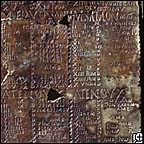 Although the Roman conquest led to the extinction of the Gaulish language 2,000 years ago, a half dozen rare, surviving Gaulish/Latin bilingual inscriptions have enabled scholars to trace the origins of the Celtic language and many other European languages.
Although the Roman conquest led to the extinction of the Gaulish language 2,000 years ago, a half dozen rare, surviving Gaulish/Latin bilingual inscriptions have enabled scholars to trace the origins of the Celtic language and many other European languages.
Peter Forster, a molecular geneticist at the University of Cambridge, and Alfred Toth, a Zurich linguist, applied DNA sequencing and analysis methods to study the inscriptions and corresponding words and word fragments from the following languages: Classical Greek, Old Irish, and the modern versions of Irish, Scots Gaelic, Welsh, Breton, French, Occitan, Spanish and Basque.
Most words were remarkably similar across the board. For example, "mother" in Gaulish is "matir," while in Latin it is "mater." Such similarities in the study were likened to mutations of inherited genes.
"Both the single-wave result and the early dates of (around) 8,000 B.C. and 3-4,000 B.C. confirm Colin Renfrew's archaeologically-based hypothesis, published in 1987, that our languages were brought to Europe and to the British Isles by the first farmers at the beginning of the Neolithic," explained Forster. "These farmers would have come from the Near East via Anatolia (Turkey)."
Findings are published in the current Proceedings of the National Academy of Sciences.
No comments:
Post a Comment